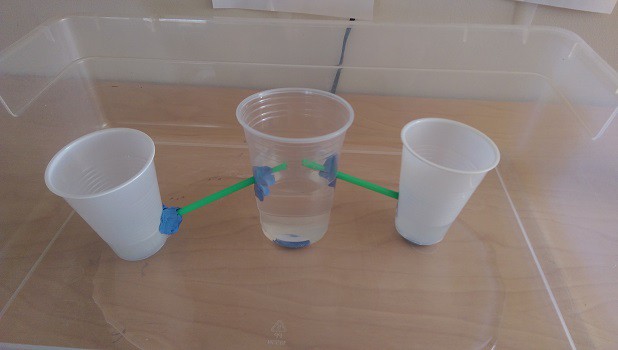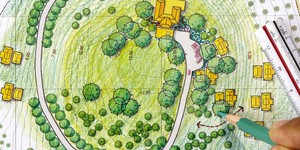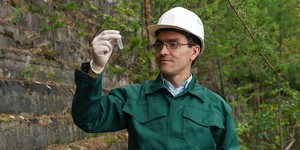Summary
This activity was inspired by: Lesson: Way to Flow – Water Irrigation, by eGFI

Introduction
Irrigation, or the artificial application of water to crops, has been used by humans for thousands of years. Ancient civilizations build complex irrigation systems without the aid of modern technology or construction equipment. Can you design a model irrigation system using some simple household materials? Try this project to find out!
Background
Irrigation systems can be vital for growing crops in areas that do not otherwise receive enough rainfall to sustain them. They are even used in areas that are near natural water sources like lakes and rivers, to help evenly distribute water amongst the crops. Modern irrigation systems can rely on heavy construction equipment to dig miles of trenches and pumps that can suck water up from deep underground. Electrical power allows us to distribute water through miles of piping across farm fields.
How did ancient civilizations manage to build irrigation systems thousands of years ago? They took many different approaches – for example, they could divert the natural flow of a river towards their crops, use lakes as reservoirs to store extra water for dry seasons, or rely on gravity-powered systems to channel rainwater coming down a mountainside. In this project you will build a simple model irrigation system using plastic cups and straws, powered by nothing but gravity. Can you design a system that evenly distributes water among different cups, simulating how a real irrigation system would send equal amounts of water to different fields?
Materials
- Paper or plastic cups (can be different sizes)
- Drinking straws
- Modeling clay
- Scissors
- Xacto knife
- Tap water
- Work area where it’s OK to spill water, like a sink, bathtub, or outdoor area
- Optional: coins, to help weigh the cups down
Preparation
- Adult supervision is required when using an Xacto knife
- If you are doing the project indoors, make sure you have towels handy to clean up any spilled water
Instructions
- Use the Xacto knife to make two small X-shaped slits about one-third of the way down from the top of a cup, on opposite sides of the cup.
- Get two more cups and make one X-shaped slit in each up, about one-third-of the way up from the bottom. The slits in the first cup should be higher than the slits in the second two cups.
- Poke one drinking straw through each slit in the first cup, then poke the other ends of the straws through the slits in the other cups.
- Use small pieces of modeling clay to form a seal around the straws inside each cup, to prevent water from leaking out.
- If you have trouble getting the cups to sit flat, put a few coins in the bottom of each one to help weigh them down.
- Slowly pour water into the central cup. You can pretend this cup represents a natural water source like a river or lake, or an area that receives rainfall, and the other cups represent locations without water. What happens when the water reaches the straws?
Extra: make this project an engineering design challenge. The instructions only tell you how to build a very simple model irrigation system, but this should be enough to get you started. Here are some additional challenges you can try. Feel free to try using other materials that are not listed in the materials section above:
- Can you design a bigger irrigation system, with more cups that all receive water from the central cup? Can you make sure that they all receive the same amount of water when you pour water into the central cup?
- Can you design a “chained” irrigation system, where water passes from one cup to the next? Is it possible to get the same amount of water in each up?
- Can you transport water over a longer distance? Can you figure out how to space the cups farther apart than one straw length?
Extra: there are also some scientific experiments you can do based on this project. What happens if you change the angles of the straws, making them steeper or shallower? Does this change how much water each cup receives? What if you change how fast you pour the water (e.g. pour the water so fast that the first cup fills up before it has time to drain through the straws, vs pouring the water slowly so it drains through the straws right away).
Observations and Results
When you pour water into the central cup, it should start flowing into the other cups once it reaches the straws. This occurs because gravity pulls the water through the straws, which are angled downward since you made the holes in the first cup higher than the holes in the other cups. To get equal amounts of water in each cup, it is important to have the straws in the central cup all at the same height. If one straw is higher than another, the cup it leads to will not receive as much water (or any water at all, depending on how slowly you pour the water – if you pour slowly enough, all of the water might go through the lower straw).
You might experience some leaks through the modeling clay seals, which is why it’s a good idea to do this project where it’s OK to spill some water!
Ask an Expert
Cleanup
- Clean up any spilled water.
Additional Resources
- Science Activities for All Ages!, from Science Buddies







